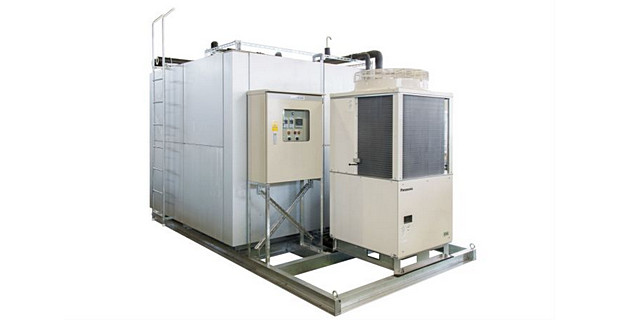New CO2 thermal storage system saves 30% on energy bills

Yamato Co. Ltd., a Japanese engineering company specialising in the planning, design and installation of HVAC&R facilities, has developed and tested a new CO2-based brine-ice thermal storage system.
Supermarkets and convenience stores can now go HFC-free quickly and easily, slashing their electricity bills by up to 30% and minimising maintenance costs using Japanese manufacturer Yamato’s newly developed CO2-based brine-ice thermal storage system.
Yamato’s use of CO2 for thermal storage builds upon its past experience of using HFCs. The system’s carbon footprint is minimal. It can replace existing HFC direct expansion (DX) systems in supermarkets or convenience stores quickly and easily without the need to close down the store.
The system has also been shown to perform significantly better than CO2 DX systems, increasing efficiency, reducing electricity demand and reducing necessary refrigeration capacity.
The ‘CO2UEI’ System
Yamato’s CO2-based brine-ice thermal storage system is named ‘CO2UEI’. UEI stands for Ultra Eco Ice and it is a patented and originally developed brine-ice thermal storage tank. This tank is connected to a CO2 refrigeration unit to form what Yamato calls the ‘CO2UEI Unit’.
Sadao Nishimura, managing executive officer for Yamato, said, “the combination of the UEI thermal storage tank and the CO2 refrigeration unit is the key innovation that has improved performance and efficiency over our past iterations of HFC-based thermal storage systems”.
At Yamato’s R&D facility in Gunma prefecture Japan, the testing unit outside of Yamato’s simulated convenience store environment.
The CO2 refrigeration unit that is connected to the thermal storage tank is Panasonic’s 10 HP CO2 outdoor condensing unit, the second generation of Panasonic’s system. It delivers CO2 at a lower pressure of 6MPa.
The brine-ice thermal storage tank itself contains multiple spiral coils of high-pressure stainless steel piping used to evaporate the CO2 and generate the brine-ice.
CO2 evaporates in the UEI thermal storage tank at around -10°C.
The brine, which is a combination of propylene glycol and water, begins to freeze at -6°C. Brine-ice is then generated and accumulated overnight.
During the day, the brine fluid exits the thermal storage tank and is circulated throughout Yamato’s simulated indoor retail environment at -6° C. This configuration guarantees zero chance of CO2 leakage inside the store as the refrigerant never enters the building and is kept outside.
Yamato’s simulated retail environment, affectionately named ‘Yamato Conbini’, consists of four refrigerated display cases: two low-temperature display cases at -6°C, suitable for fish and meat, and two display cases at -3°C, suitable for fruits, vegetables, and other daily consumables. The -3°C showcases are cooled by brine leaving the low-temperature showcase (warmed to about -3°C).
Inside the store, Yamato demonstrated the ease of converting HFC showcases simply by removing the expansion valves and directly connecting the brine supply.
This is an additional benefit for end users since the process of changing existing HFC or HCFC-based display cases can be carried out simply by installing the CO2UEI unit outside without closing the store.
Testing the ‘CO2UEI’ system
Yamato has been testing the system since September 2016, in various conditions, to see how it performs in different simulated environments.
Among the challenges encountered were finding the appropriate amount of refrigerant and controlling the circulation of oil, especially in summer conditions. Once these issues had been resolved, the team collected data and measured performance over the next few months.
Yamato found that the CO2UEI system outperformed standard CO2 DX systems in three main areas:
- Energy efficiency (kWh): The average coefficient of performance (COP) for the CO2UEI system was 2.78 compared to 2.55 for standard direct expansion – an improvement of 9%.
- Electric power consumption (kW): As a result of the increased COP, electricity consumption decreased by 30% and daytime peak power demand was cut.
- Refrigeration capacity (kW): Increased COP and leveling of electricity consumption resulted in the reduction of required maximum cooling capacity by 35% – therefore reducing the size of the CO2 unit.
Customer benefits
All this translates to multiple benefits for end users – not only in terms of reducing operating costs, but also in increasing safety and minimising maintenance.
The use of the UEI thermal storage unit to produce and store ice overnight reduces peak daytime electric power demand, significantly lowering electricity costs and reducing the cost of the refrigeration unit. Because the system limits the circulation of CO2 refrigerant to outside the building, the risk of leakage inside the store is eliminated.
High-pressure refrigerant piping only exists directly between the CO2 refrigeration unit and the UEI thermal storage tank, minimising maintenance costs and increasing the system’s overall reliability.
Using the Panasonic 10HP refrigeration unit reduces the overall size and weight of the system, which means the space needed for installation, outside the store, is minimised.
The Yamato system offers supermarkets and convenience stores the opportunity to transition away from f-gases while also reducing their costs and improving their environmental sustainability.
What’s next?
Yamato will present the system in detail at the ATMOsphere Japan 2017 conference, taking place in Tokyo on 20 February 2017.
The company predicts that the market for natural refrigerants will continue to grow.
“We believe the CO2UEI system has the potential to reduce energy costs and increase efficiency for a number of retailers who wish to transition away from their legacy f-gas based systems,” Nishimura said.
